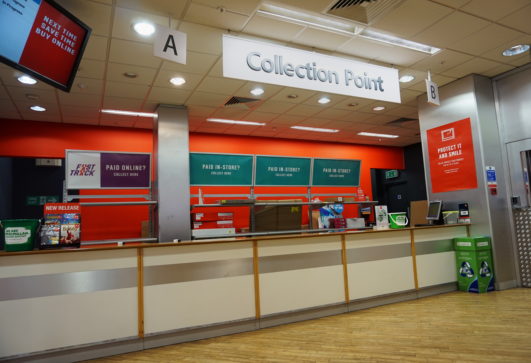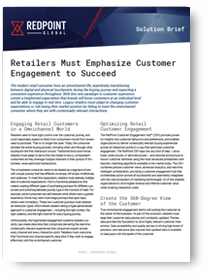
If you are a typical retail consumer, you’ve likely bought an item online and picked it up at a store sometime in the past year. What’s commonly referred to as BOPIS (buy on-line pick-up in-store) hits all the right notes for today’s sophisticated consumer. It combines the convenience and control of a self-guided online experience with the instant gratification and cost-effective benefits of same-day pickup, with the added bonus of not having to worry about the dreaded porch pirates.
It is no wonder, then, that an estimated 60 percent of U.S. consumers used BOPIS in 2017, up from just 35% in 2015. From the customer’s perspective, “click and collect” appears fairly easy to execute all around – I click “buy now,” I jump in my car and go pick up my new TV, how hard is that? Many large retailers agree – including Walmart, Kohl’s, Home Depot, and Best Buy – and have rolled out BOPIS strategies with varying levels of success over the past few years.
Retailers are beginning to adopt the practice to meet customer expectations and to enhance the overall customer experience. Retailers that do not offer the service should be aware that customers notice; one survey revealed 50 percent of consumers who have used BOPIS said that if they wanted an item and the retailer didn’t offer the option, they would choose a retailer who did. The online experience is so ingrained in today’s culture that consumers can’t compute not being able to go to a local store to pick up an item they’ve bought online.
As for enhancing the customer experience, customers embrace BOPIS for many reasons. Most cite avoiding shipping costs (88 percent) and because it’s easier to browse for products (77 percent), but other reasons including immediacy, reliability, and flexibility of an in-store pickup. BOPIS done right is a tremendous opportunity to generate a satisfied (read: loyal) customer. A customer “wowed” by the experience is likely to tell a friend or two, and statistics also show that once at the store the customer is likely to make an additional purchase.
BOPIS was well represented with sessions at the recent NRF 2019, Retail’s Big Show event in New York. At one session, Jude Reter, VP of Digital Experiences at Express, discussed the store’s pilot BOPIS roll out where Express used lockers for the in-store pick-up location. Reter said that the use of lockers resulted in a 21 percent increase in weekly BOPIS orders at the pilot locations, with a 19 percent revenue increase. Also, 25 percent of BOPIS customers made an additional purchase vs. just 8 percent when lockers were not used.
Great for the Consumer, Challenging for the Retailer
Executing a friction and frustration-free BOPIS implementation is more difficult to pull off than most customers – and even some retailers – appreciate. The truth is, a seamless, end-to-end BOPIS process is a delicate dance wrought with potential missteps, each with the potential to derail a positive customer experience.
Rather than resulting in referrals and additional purchases, a poor BOPIS experience runs the risk of shared horror stories and a lost customer: A wait in line, a misplaced item, the wrong item, an item that’s not ready when promised, an item delivered to the wrong store, or – worst case – a rude store clerk who has no record of the transaction.
Other potential roadblocks exist behind the scenes and have just as much potential to introduce friction into the customer experience. These include supply chain tracking and other logistic concerns, staff training costs, and storage considerations. Decisions for retailers include whether to offer curbside pickup or dedicated parking, where to put the pick-up location, what inventory will be eligible for BOPIS, and how soon to make pick-up available. There are also endless considerations that pertain to the online experience – is it easy for the customer to find the in-store pick-up option on your website, what is the confirmation process, what information will you collect, do you offer guest checkout?
Advanced BOPIS capabilities include expanding the omnichannel experience to include features such sending a push notification to a customer when they’re in route to the store, letting them know where to go and what to expect, or using geo-fencing to send a cross-sell discount offer for in-store redemption.
With so many avenues to potential customer friction, it’s no wonder that according to a 2017 JDA survey that 75 percent of US store managers say they have difficulty implementing a successful BOPIS strategy, and just one-third are able to offer a discount to a customer who does choose the BOPIS model.
Data’s Role in Bringing BOPIS to Life
A major reason why BOPIS poses so many complex challenges for what the consumer appears to be a straightforward, two-step process (click, collect) is marketing silos. For starters, if your ecommerce system isn’t integrated with your POS systems, effective BOPIS is a non-starter. It seems obvious, but providing a retail location with real-time knowledge about a customer’s online purchases is BOPIS 101.
A customer data platform (CDP) breaks through marketing silos and provides the organization with a single point of control over customer data that is the baseline for implementing a successful BOPIS strategy. A CDP ingests data from any customer data source, providing a unified customer view that is accessible across the enterprise and allowing marketers to move at the pace of the customer – such as being prepared to fulfill an online order at a physical location and other omnichannel orchestration efforts.
Armed with the unified customer view and the ability to recognize a customer at any online or offline touchpoint at every stage of the customer journey, the enterprise can take BOPIS to the next level by offering a next-best action throughout the entire process.
Hyper-personalized interactions delivered in the right cadence are made possible with machine learning and artificial intelligence (AI) algorithms that take into account every single data point about the customer – first-party, second-party, and third-party data – to generate the next-best action that has the best chance to enhance the customer experience. In a successful BOPIS program, this could mean providing a free TV mounting with the purchase of mounting hardware at pick-up, or perhaps offering a 5 percent discount on take-out at a partner restaurant that can be redeemed on the way home from the store.
From the customer’s perspective, a next-best action generated during a BOPIS experience should appear as natural as buying an item online and picking it up at the local store; if the customer doesn’t think twice about it, you know you’ve done something right. While the technology is there to ensure the elimination of any potential friction in a well-designed BOPIS strategy, the real danger is inaction.
Because let’s face it, today’s sophisticated customer accustomed to an omnichannel experience will find it far-fetched to believe that any top retailer lacks the capability to execute a flawless “click and collect” process. The biggest source of friction a retailer must worry about is not that the BOPIS strategy is less than perfect, but that a customer buys from a competitor because you don’t offer it at all.
RELATED ARTICLES
Retailers: This Holiday Season Focus on Actions Not Offers
How to Personalize Retail Experiences Without Being Creepy
How to Benefit from the Digital and Physical Retail Convergence

